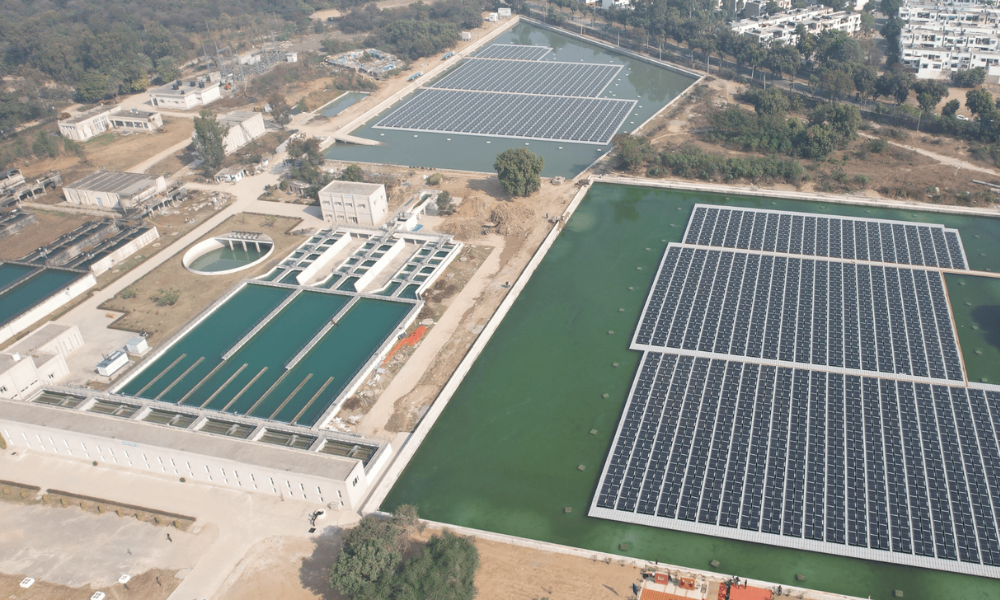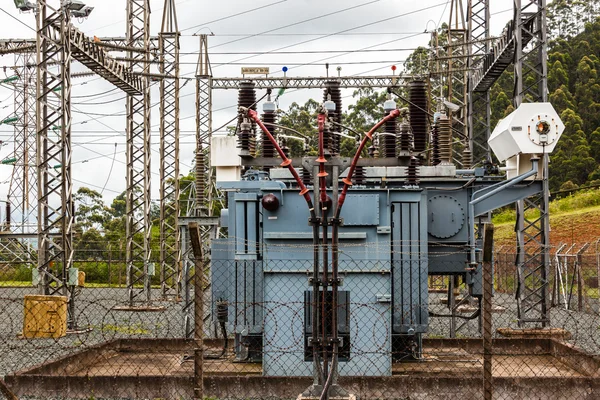With the increasing demand for energy in India, solar power has emerged as a sustainable solution for meeting the country’s energy requirements. As solar power becomes more popular, new and innovative ways of harnessing the sun’s energy are being developed. One of these innovative solutions is the use of solar panels in floating solar projects. Floating solar panels are a somewhat new concept in India, but they have gained significant traction in recent years.
One company at the forefront of the floating solar panel movement in India is Hartek Solar. The company specializes in the design, engineering, and installation of Industrial, commercial, and floating solar rooftop systems and is one of India’s top 3 rooftop solar installers.
Recently, Hartek Group has built North India’s largest floating solar plant in Chandigarh. Through this article, we will take a closer look at some of the floating solar projects that have been undertaken in India.
List of Floating Solar Projects in India:
1. NTPC Floating Solar Plant Ramagundam (100 MW)
The 100 MW NTPC Floating Solar Plant at Ramagundam is an engineering marvel that combines advanced technology with eco-friendliness. This project, constructed by M/s BHEL with a budget of Rs. 423 crores, spreads over 500 acres of the reservoir and is divided into 40 blocks, each capable of producing 2.5 MW of power.
One of the most remarkable features of this project is that all the electrical equipment, including the inverter, transformer, HT panel, and SCADA, are located on floating ferro cement platforms anchored to the dead-weight concrete blocks. This arrangement not only maximizes space utilization but also reduces the evaporation rate from the water body underneath the solar modules, thereby conserving water and improving the efficiency of power generation.
By using HDPE material for the floaters and special HMPE ropes for anchoring, this project has demonstrated the use of cutting-edge technology in renewable energy. Additionally, the project will help reduce coal consumption by 1,65,000 tons and CO2 emissions by 2,10,000 tons per year.
2. NTPC Floating Solar Plant Kayamkulam (92 MW)
The National Thermal Power Corporation (NTPC) has recently set up a 92-MW floating solar power project at its Kayamkulam unit in Kerala, making it the second-largest floating solar power project of NTPC after the 100-MW plant at Ramagundam in Telangana. The floating solar system, built on a 450-acre lake area next to the NTPC’s Rajiv Gandhi Combined Cycle Power Project, consists of around 3 lakh Made in India solar PV panels floating on water.
At a cost of ₹465 crores, the project is estimated to reduce carbon emissions by 1.73 lakh tonnes every year, and could help light up around 26,000 households daily. The NTPC has around 1,000 acres of land suitable for floating solar projects and has recently commissioned a few small solar projects at the Kayamkulam site.
The Kerala State Electricity Board has signed an agreement with the NTPC for purchasing power from the floating solar station at ₹3.16 per kWh. The project has enabled NTPC to shift its focus to solar energy, after KSEB stopped drawing power from the 359-MW naphtha-fuelled RGCCPP in 2017 due to cost concerns.
3. Rihand Dam Floating Solar Power Plant (50 MW)
The Rihand Dam Floating Solar Power Plant is a significant renewable energy project in India, located on the Rihand reservoir in Uttar Pradesh. The project has a total capacity of 50 MW.
What’s unique about this project is that it’s a joint venture between the state-owned NTPC and the Uttar Pradesh New and Renewable Energy Development Agency (UPNEDA). The power generated from the project will be sold to Uttar Pradesh Power under a power purchase agreement for a period of 25 years.
The rate of $0.044kWh has been fixed for the sale of power, making it an attractive option for both the buyer and the seller. This project is expected to contribute towards meeting the state’s increasing power demand and reducing its carbon footprint.
4. Simhadri Floating Solar PV Project (25MW)
NTPC, one of India’s leading energy companies, has demonstrated its commitment to driving the development of renewable energy in the country with the completion of its 25MW Floating Solar PV Project.
This impressive project, located on the raw water reservoir of NTPC Simhadri Super Thermal Power Project, is one of the largest floating solar power projects in India and is expected to generate an annual energy yield of 55.11 million units while saving 47.5 metric tonnes of CO2 emissions per year.
What sets this project apart is NTPC’s commitment to developing the floating solar industry in India, even without a firm tie-up for off-take of power. The project was awarded to M/s BHEL in 2019 under the EPC development model, and the unique anchoring system used in the project is the first of its kind in the country.
Spread over 75 acres, this floating solar project has the power to generate electricity from more than 1 lakh solar PV modules, providing power to around 7,000 households and saving 1,364 million litres of water per annum. This sustainable energy project is a testament to NTPC’s commitment to reducing carbon emissions and providing affordable, uninterrupted electricity through environmentally friendly energy projects.
Furthermore, NTPC is also making a plan to set up a hydrogen-based micro-grid system at Simhadri on a pilot basis, further showcasing its commitment to innovation and driving the transition to a cleaner, greener energy future.
5. 2 MW Floating Solar Power Plant at Chandigarh
Mohali-based Hartek Solar has constructed the North’s largest floating solar power plant, with a capacity of 2 MWp, at a water reservoir in Chandigarh that supplies water to the entire city. The solar plant is situated at Sector 39 Water Works and is expected to generate 28,00,000 units of electricity per year, helping offset 80,000 tonnes of CO2 emissions.
This innovative project involves installing solar panels on the surface of a water reservoir to generate renewable energy. Apart from providing a renewable source of energy, the project has other benefits as well. One of the major advantages is the reduced evaporation of water due to the installation of solar panels, which amounts to approximately 382 million litres annually.
Another advantage is the cooling effect of water, which enhances the efficiency of the solar panels and generates more electricity than other solar power plants. The floating solar plant will provide sustainable energy and help reduce the city’s carbon footprint while also contributing to water conservation efforts.
Hartek Solar, the rooftop solar division of Hartek Group, secured this order from Chandigarh Renewal Energy and Science & Technology Promotion Society (CREST). The floating solar plant project is a significant milestone in the region’s push towards renewable energy and will serve as a model for other cities to follow.
Final Words
One of the key advantages of floating solar projects is that they offer higher energy yields compared to ground-mounted solar projects. This is because the floating panels are able to generate electricity from both solar radiation as well as from the reflected sunlight off the water’s surface.
Additionally, floating solar projects also help to reduce water evaporation and algae growth and improve the water quality in the reservoirs.
If you are looking to adopt clean energy solutions for your business or organization, Hartek Solar’s expertise and commitment to sustainability make them a great partner to work with.
The company has recently got a contract from SJVN Green Energy to build a 22 MW floating solar PV power project at Nangal Pond, Himachal Pradesh. This project will become North India’s largest floating solar power plant upon completion.
To learn more about how Hartek Group can support your transition to clean energy, contact them today and take the first step towards a greener future.
FAQ’s about Floating Solar Projects:-
1. What is floating solar power?
Floating solar power refers to solar panels installed on water bodies, providing renewable energy while reducing water evaporation.
2. How does floating solar improve efficiency?
The cooling effect of water enhances panel efficiency, generating more electricity compared to traditional land-based solar projects.
3. Which is the largest floating solar project in India?
The NTPC Floating Solar Plant at Ramagundam (100 MW) is India’s largest floating solar project.
4. What are the benefits of floating solar panels?
They save land, reduce water evaporation, lower carbon emissions, and improve power generation efficiency.
5. Why choose Hartek Solar for floating solar projects?
Hartek Solar is a leading expert in designing and installing industrial, commercial, and floating solar systems in India.
Share:
Explore More
Keep up to date with the most trending news stories that are shaping the world today.








